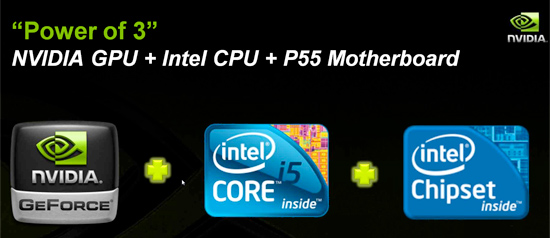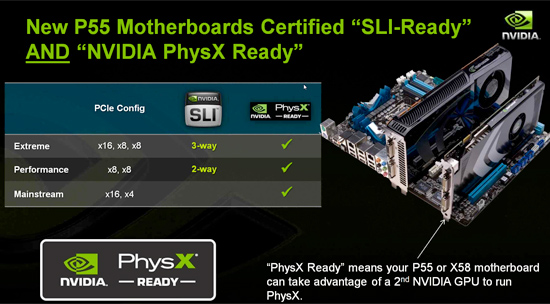Preparing for P55: Motherboards, Memory and NVIDIA
by Anand Lal Shimpi on August 20, 2009 4:00 PM EST- Posted in
- Motherboards
NVIDIA and P55
Yesterday NVIDIA held its Power of 3 platform briefing. The intention was to align NVIDIA’s GPUs, SLI and PhysX with the Intel Lynnfield/P55 launch. NVIDIA has no Lynnfield chipsets out (but is expected to sometime next year), instead it is providing SLI licenses to those motherboard makers that are interested in supporting multi-GPU on their boards.

The license terms are thankfully a lot more palatable than they were with the initial X58 launch. To support SLI a motherboard manufacturer simply has to pay NVIDIA $30,000 up front plus $3 per SLI enabled motherboard sold. In turn NVIDIA gives the motherboard manufacturer a key to put in its BIOS that tells the NVIDIA display drivers that it’s ok to enable SLI on that platform.
As I’ve mentioned in the past, Lynnfield includes an on-die PCIe controller provided 16 PCIe 2.0 lanes. Using an external switch those 16 lanes can be split off into two x8 slots, enabling CF and SLI (CF is enabled free of charge, SLI requires participation in the licensing program).
Although unnecessary, if you want the bandwidth of two x16 PCIe 2.0 slots the motherboard manufacturer will need to use an nForce 200 chip. This chip houses 32 PCIe 2.0 lanes but connects to the Lynnfield chip via 16 lanes, so you get better bandwidth between cards but no increase in bandwidth between the GPUs and the CPU. Expect boards that use an nForce 200 chip to be limited at best.
Without the PCIe switch logic to split the x16 connection off of Lynnfield into two x8 connections, SLI can’t be enabled; NVIDIA won’t allow it over mismatched PCIe slots (e.g. x16 + x4).
In an unexpected alignment, NVIDIA is actually calling out AMD’s Dragon platform by name (Phenom II + AMD 700 Series Chipset + AMD 4800 Series GPU). NVIDIA calls its “platform” the Power of 3, of course referring to Intel’s P55, Intel’s Lynnfield and a NVIDIA GPU. Intel gets it for free here; NVIDIA does all of the branding and promotion for Power of 3, yet Intel makes the vast majority of the silicon. Perhaps someone is bitter over not being included in AMD’s platform launch plans anymore?
All kidding aside, at least this means we will see mature driver and SLI support for Lynnfield at launch. While NVIDIA was in good shape when X58 debuted last year, AMD’s driver support left much to be desired. It’s clear that even NVIDIA with its anti-Intel blood sees the importance of Lynnfield; it’s nice to see egos checked at the door.

There’s one more logo program that’s being introduced with Lynnfield SLI certification: PhysX Ready. Yep, you read that right. NVIDIA is now allowing motherboard makers who are SLI partners to put a PhysX Ready logo on their boxes if they have enough PCIe slots to support a second GPU as a PhysX card.

You may remember that we weren’t overly impressed with PhysX the last time we looked at it, but NVIDIA promises that the use of PhysX in Batman: Arkham Asylum is beyond anything we’ve ever seen. We’ll find out next month when Batman ships.










59 Comments
View All Comments
strikeback03 - Tuesday, August 25, 2009 - link
$130 is 76% of $170, so even if the processor costs the same and you ignore the differences in RAM cost and performance, there are plenty of people who will be happy to get close to the performance of the 1366 platform for that discount. The preview showed a ~5% difference, we'll see what the retail processors show but I don't doubt there will be plenty of people happy to go P55 if they can get 95% of the performance for 76% the price of the i7/1366. Don't mention gaming, most of these quad-core processors are not as good a value as a fast dual-core today anyway.Plus, remember, people have bought and overclocked Celerons before.
Natfly - Friday, August 21, 2009 - link
Well in the article Anand mentions that the cheapest P55 would be just under $100, I figured the midrange would be $130 or so, with midrange x58 boards being around $200.As for the prices of the Lynnfield lineup, multiple sites have confirmed the price points. Fry's even accidentally listed one of the processors: http://www.fudzilla.com/content/view/15040/35/">http://www.fudzilla.com/content/view/15040/35/
If you want to nitpick about speculation vs facts, then even the performance of these is speculation, considering all previews/reviews have been with engineering silicon and beta bioses.
Celerons were/are crippled, less cache, slower clock speeds, slower fsb, fewer supported instruction sets. All around, greatly reduced performance.
Lynnfield is not crippled. It may not have the third memory channel or QPI, but neither of those dramatically affect performance, especially in the majority of apps. In trade for these Lynnfield gains higher turbo modes, lower tdp, smaller package, and an on-die PCIe controller. In several ways it is more advanced than the 1366 processors.
JustPassing - Friday, August 21, 2009 - link
I hope that it is intentional that you incorrectly refer to P55 as x55. If not, you make yourself look like even more of an idiot, if possible. :Pdtgoodwin - Friday, August 21, 2009 - link
It seems to me that most seem to be forgetting the advantage the i5 will have with the much higher turbo overclocks. Most of the time, this will make the i5 quite a bit faster than it's comparable base speed i7. Yes, the platform is surprisingly expensive for a "cut down" version of the i7, but I suspect within a few months, it will find it's place in the market and be an very desirable combination for those wanting better performance than Penryn or Phenom II, but without the higher cost of the i7.TA152H - Friday, August 21, 2009 - link
You're assuming the i7 won't be changed. It's HIGHLY unlikely Intel would make the boost higher on the lower end chip. They're not that stupid.ClagMaster - Thursday, August 20, 2009 - link
I am looking forward to the Lynnfield/P55 launch next month. The P P55 motherboard product line looks really good. For $130, a user can get a really nice motherboardThis launch is really directed toward advanced mainstream users who are willing to invest $600-$700 in a CPU/Mobo/Memory/Graphics Card upgrade. Four DDR3 slots for 8GB of memory is more than adequate for mainstream usage.
If everything holds true with Lynnfield/P55, i7/X58 performance is available for about 70% the cost.
bamacre - Thursday, August 20, 2009 - link
Come on, even Dell's X58 systems have 6 dimm's. Memory is still cheap, there's no reason for these high-end boards to skimp on dimm slots. Most of us were paying $200 for 2GB kits just a few years ago, and you can get 12GB for less than that now.JarredWalton - Thursday, August 20, 2009 - link
The Lynnfield platform is dual-channel, so six slots means you need to support three DIMMs per channel. That introduces latency and signaling issues, and I wouldn't be surprised if there's a restriction on what sort of modules you can use (i.e. you may only be able to use one double-sided DIMM with two single-sided DIMMs in each channel if you want to populate all six slots).nuttie43 - Thursday, August 20, 2009 - link
So...in Europe at least motherboards are already showing up in stock. The cheapest are almost as cheap as X58. What is the point of getting 1156 & I5 when 1366 & I7 cost the same?TA152H - Thursday, August 20, 2009 - link
Have you ruled out stupidity?